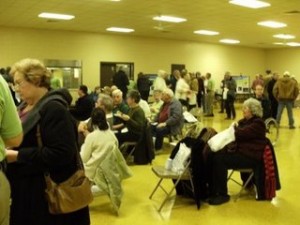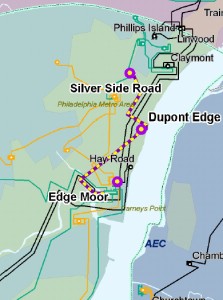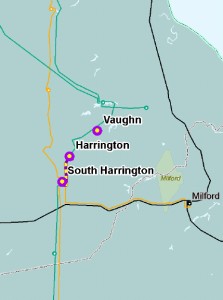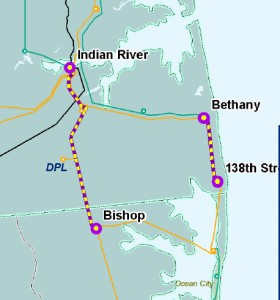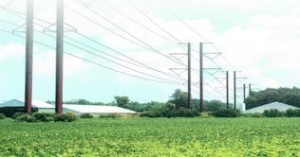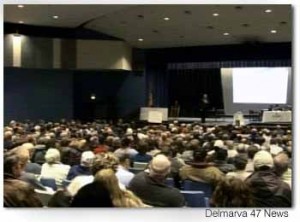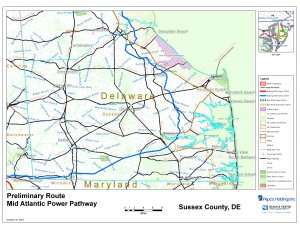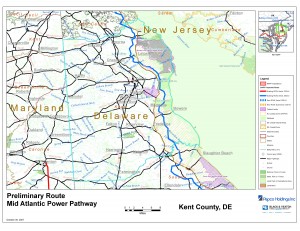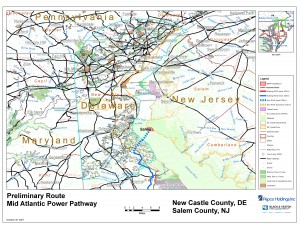Sussex meeting on Delmarva Power/PEPCO’s Mid-Atlantic Power Pathway
February 9th, 2009
We’re stuck here in Minnesota for a while, parental health issues to deal with, and thankfully others have posted on the meeting this week in Delaware about the Mid-Atlantic Power Pathway proposed by Delmarva and PEPCO.
His post shows that it’s the same everywhere — coffee & cookies and 20 utility employees to “explain.” TWENTY!
From his blog — does this scene look familiar:
AND knowing that 600 showed up in Maryland, that there’s lots of interest, he notes that there were only 30 chairs. Come on, PEPCO, that is SO tacky…
This project is part of something much bigger…
Here’s my post on RTEP – Regional Transmission Expansion Plan
Here’s some info about their plan, the original proposal, and info about AC v. DC lines, focused on the submarine cable for the Chesapeake Bay:
FERC has approved a Return on Investment of 12.8%:
The June 12 PowerPoint says it will cost $1.5 billion, and the FERC press release says $1.05 billion. Slip of the decimal?
Take a look at their Market Efficiency Analysis — projections of cost and revenue changes:
In short, here’s what this line is about:
I found a powerpoint with some of the upgrades planned:
Here are maps to some Delaware projects from this September powerpoint:
Xcel’s Hiawatha Project in MinnPost
February 8th, 2009
This article was in MinnPost on Friday, somehow I missed it — Steve Berg did a great job spelling it all out. Perhaps Xcel will get the message that they’ve really screwed up and need to do this differently?
Here’s the referenced Minneapolis City Council Health, Energy and Environment Committee’s Resolution:
And here’s Steve Berg’s article in toto:
Power lines over the Midtown Greenway? A classic case of destroying a place to save it
Transmission in NYT today
February 7th, 2009
Matthew Wald has a good piece in the NYT today, good in that it raises some of the issues, but these issues raised need some more digging, can you dig it?
Check this paragraph from the article:
In fact, energy experts say that simply building a better grid is not enough, because that would make the cheap electricity that comes from burning coal available in more parts of the country. That could squeeze out generators that are more expensive but cleaner, like those running on natural gas. The solution is to put a price on emissions from dirtier fuels and incorporate that into the price of electricity, or find some other way to limit power generation from coal, these experts say.
Not “could,” but WOULD “squeeze out generators that are more expensive but cleaner” and adding externalities to coal generation cost would only stop that, would only be a “solution” if it tacked on HUGE costs, far greater than those anticipated by those advocating either Cap & Trade or Tax.
But those of us in transmission are glad to see the driver for new construction exposed, as it was in the MISO Benefits Study by our good friends at ICF:
RTO operational benefits are largely associated with the improved ability to displace generation with coal generation, more efficient use of coal generation, and better use of import potential.
Here’s that MISO study, the above quote comes from the conclusions, p. 83, and is also stated in the intro — THIS IS THE REASON FOR TRANSMISSION, THIS IS THE REASON FOR THE MIDWEST MISO MARKET. Read the study:
ICF’s Independent Assessment of Midwest ISO Operational Benefits
For example, Jose Delgado whining about hwo long it took to get the permit for Arrowhead, what does he expect for a project that was an absurdly obvious ploy for a superhighway for bulk power portrayed as a “local load” need for WUMS? They put together many options in the WRAO report, and selected one, Arrowhead, “3j,” as the be-all and end-all of transmission. That was declared the ONE line that would fix Wisconsin. Then, next thing you know, they still want to do “5” more commonly known as the Chisago project, they want to do “9” in SW Minnesota claiming “it’s for wind” when there’s only 213-302MVA coming off of Buffalo Ridge into the Nobles substation, they do them all because that’s what they want, they can ship bulk power. It’s been so dishonest… Utilities have been so dishonest…
And let’s look at the financing of these lines. CapX 2020 testimony and a powerpoint demonstrate that they don’t have the financing lined up for that $2 billion dollar project. They were working through Lehman Bros. so what does that say? The “Cap” of CapX 2020 is “Capital” and they don’t have it. But because they want it, they’ll make us pay for it. Is something wrong with this picture?
———————————————–
Hurdles (Not Financial Ones) Await Electric Grid Update
“We burn up three years on a line that will take two months to build,” he said.
600 show up for Delmarva Power transmission line meeting
February 6th, 2009
WOW! “Nearly 600” show up for a meeting about transmission. Good, Delmarva deserves that kind of response for their threat to ram the Mid-Atlantic Power Pathway transmission line through Maryland and Delaware to New Jersey. They’re so desperate that they’re threatening “rolling blackouts:”
More transmission lies. WDMT caught them making the same threats:
Delmarva Power Community and Communications Coordinator Matt Likovich said, “There have been projections that if we don’t do something to improve our infrastructure… we could be faced with rolling blackouts by the year 2011.”
Threatening rolling blackouts, saying that’ll happen by 2011, so we need to build this line by 2013… yeah… sure… whatever… Get a grip, guys, we are not that stupid, we’re not buying your threats — it is SO naughty to do that.
Power lines would relieve congestion
Sussex Co. transmission meeting tonight
February 4th, 2009
Tonight is the final meeting in the group scheduled by Delmarva Power about the Mid-Atlantic Power Pathway, transmission through Delaware to New Jersey.
Wednesday, February 4 @ 6 p.m.
Millsboro Civic Center
322 Wilson Highway
Millsboro, Delaware
Sussex County:
Kent County:
New Castle County (cutout):
For more info on the underlying scheme, see my prior post:
